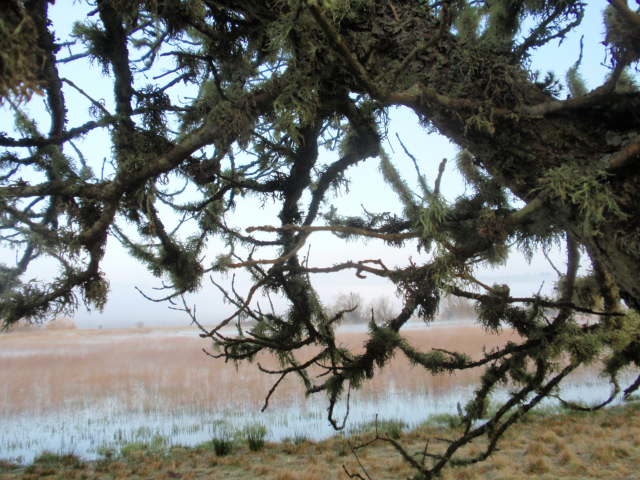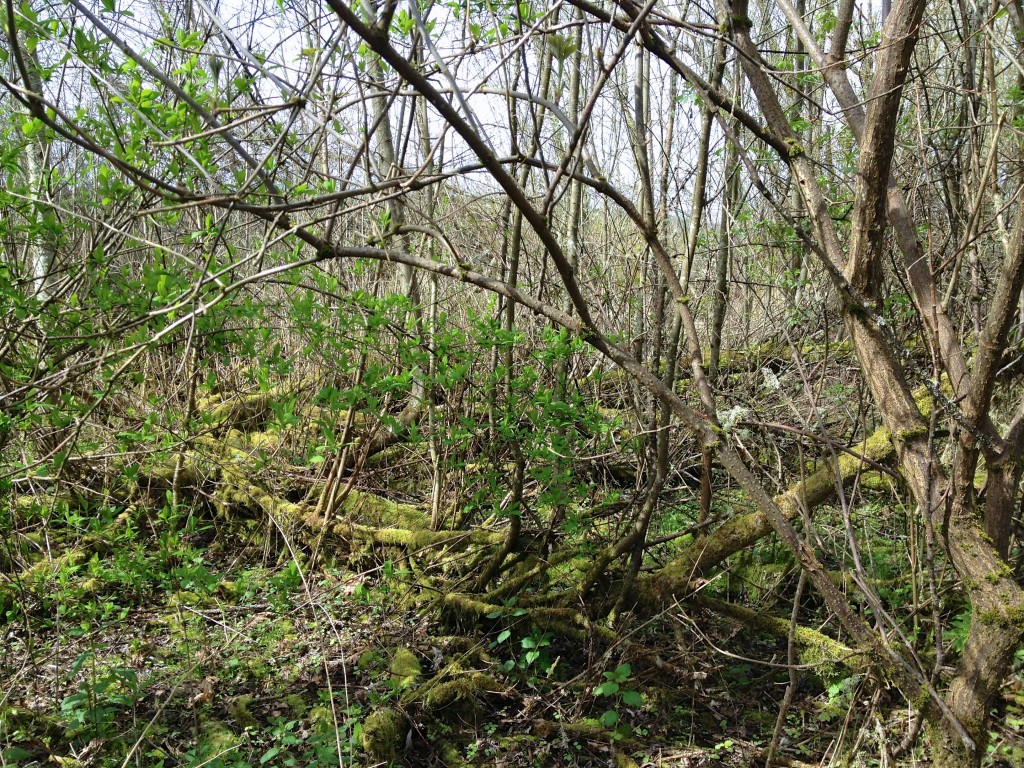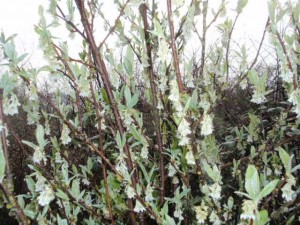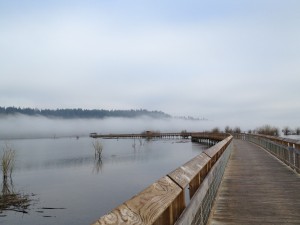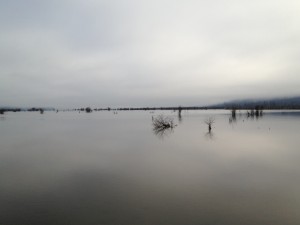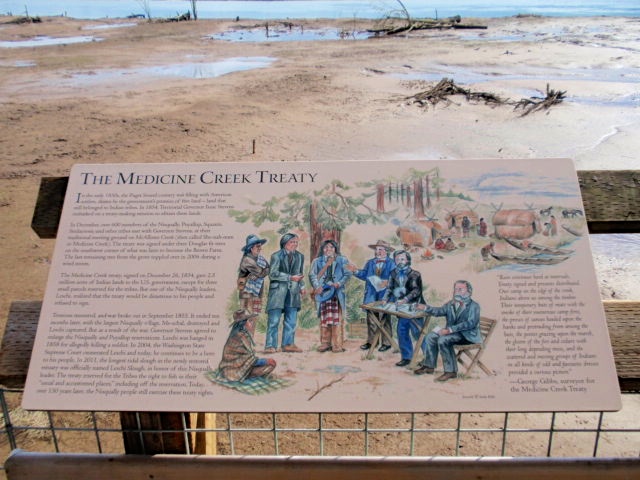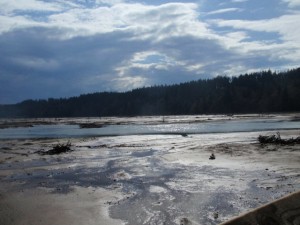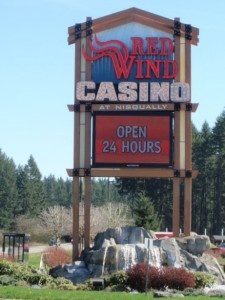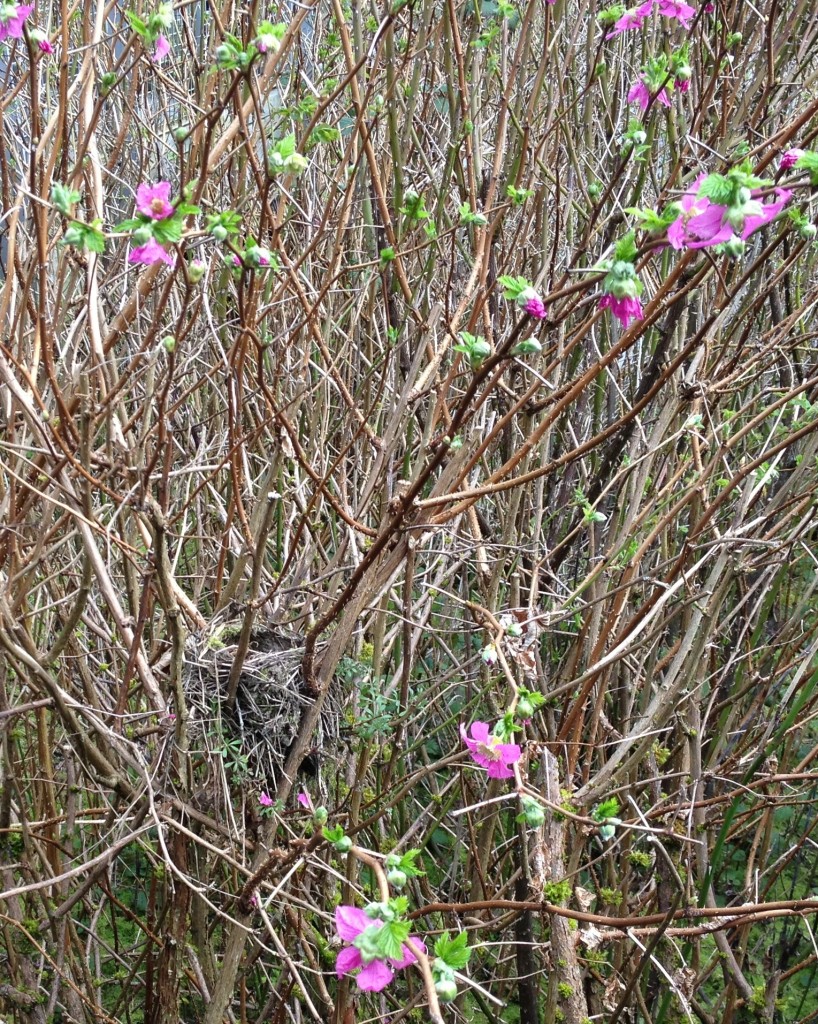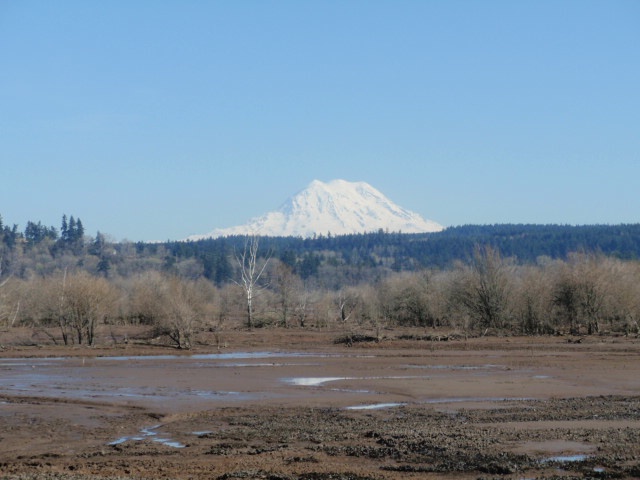Healing the Nisqually: 160 Years after the Medicine Creek Treaty
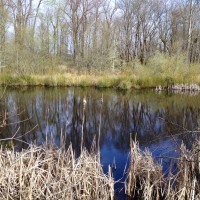
A seemingly simple attempt to recount impressions of a brief, local destination trip can sometimes surround and engulf the storyteller like the ever-widening series of concentric circles emanating from a stone dropped into a pool of water. Such is the nature of the story I am about to relate here, involving a remarkable local environment and its complex mosaic of social, political, and environmental histories.
The location that I recently visited while on spring break last month, the Nisqually National Wildlife Refuge, is a place I had wanted to see and write about since the new boardwalk, built to traverse part of the salt marsh there, was opened in 2011. I thought I would take some pictures of the estuary that is in the process of recovering from having been diked and partially farmed over the past century, and that sharing and writing about my pictures might lead me to make some additional general comments about salmon recovery in this part of the Pacific Northwest. And that is true. But it turned out that there was far more for me to notice, learn, and write about once I started exploring.
First, even the most cursory online research beginning with the place name “Nisqually” is going to lead, not just to information about the Nisqually River (which flows down from the Nisqually Glacier high on Mt. Rainier, 78 miles away), but also to the Nisqually Tribe who belong in this area just like the river itself. And even a brief search related to the Nisqually people is going to lead to the story – which I had certainly heard about, but not in enough detail that I could teach someone else about it – concerning a charismatic Nisqually leader of the nineteenth century who was hanged by the order of the governor of the Washington Territory, yet is today considered such a hero to indigenous people that a complex of Indian schools in the region is named in his honor: the Chief Leschi Schools.
And there was even more that I learned and had to ponder. In most instances when we talk today about such topics as “salmon recovery”, we must also talk about industrially polluted rivers, greedy, profit-mongering trashers of the environment, sick, stinking, cesspools of water that hardly seem capable of supporting life, and ugly, naked, totally logged formerly forested areas that, of course, are further contributing to the environmental devastation that many of us now want to remedy. In short, we expect “bad guys” to show up in the story, all looking like that cheerily heartless banker character in the game Monopoly.
Furthermore, our images of “the good” in this context have been shaped by the gorgeous photos and videos we have seen of pristine nature exemplified by soaring bald eagles, thrashing chinook salmon making their way upstream to spawn, and sparkling clean waters linking mountain to sea. Rarely does anyone but a biologist pay attention to the inestimable worth of the more lowly lifeforms that make such natural beauty possible. How many of us would be excited to get in a car to travel to photograph evidence of the largely invisible biomass composed of bacteria, microscopic insect and plant life, sand worms and other such forms of life so necessary to keep the whole food chain healthy? As I learned from reading the modest displays at the Visitor Center, however, an estuary is a “detritus mill” receiving input from both incoming and outgoing tides, and this muddy stew is actually amazingly rich in life-sustaining nutrients. So much for simplistic assessments of what’s valuable!
So I began to realize that the easy generalizations that we typically use to construct the plot line of a “recovery” story were not going to work here. As salmon rivers go, the Nisqually was relatively lucky. Yes, the Scandinavian settlers who initially worked so hard to remove the trees growing next to the river (Who among them knew how important shade is to salmon in summer?) did indeed do harm to the environment. Likewise, they did not realize how their efforts to dry out the Ohop Valley and make it better for dairy farming (by painstakingly digging a straight ditch to replace the meandering river so that the water could flow predictably through their fields) would jeopardize the immature salmon that need multiple mini-currents of varying speeds and distances from the bank. But when these mistakes based on ignorance were added to the consequences of overfishing, the establishment of salmon canneries in the region, logging, and other polluting forms of development, environmental decline was inevitable.
And of course what we recognize today as a formidable obstacle to returning salmon – dams built across downward-running rivers to generate hydroelectric power – have also negatively impacted Nisqually River salmon. But on the other hand, there is no big city or disastrously polluting riverside industry anywhere along this river from mountain to sea. Furthermore, the two dams built on the Nisqually happen to be located high up on the river, beyond a massive rock ridge that the fish never got beyond to spawn anyway, so despite the damage done to returning salmon by the high-pressure release of water, the environmental harm done to the watershed here has not been nearly so deadly as that which has occurred in other watersheds in the country.
I absorbed all of this new information bit by bit over the course of several visits to the Nisqually National Wildlife Refuge during the last two weeks of the month of March. And yet, the overall image I had originally intended to use to unify the essay that I had initially planned to write is still appropriate: that of multi-dimensional healing. Only now, having confronted and absorbed more tribal, regional, and environmental history than I had formerly been aware of, the understanding I have about “healing” is much more complicated than I first envisioned it would be.
My journey did not start out this thoughtfully. On my first visit to Nisqually since the new boardwalk was opened, I was simply excited to have the day free to explore a place I had long wanted to visit since the hundred-year old dikes had been deliberately broken to allow the estuary to begin to recover. It was, after all, an early spring day just beckoning to me to “come and see”.
Although it was not a brilliant blue-sky day the first time I visited, the colors were still almost too much to bear, coming so close to the end of winter. The greens, in those parts of the riparian woods where leaves were already coming alive and throbbing with new life, almost hurt my eyes with their intensity.
In those places where the dull tans of last fall’s cattails met with the brighter colors of water and fresh new growth, the contrast was stunning.
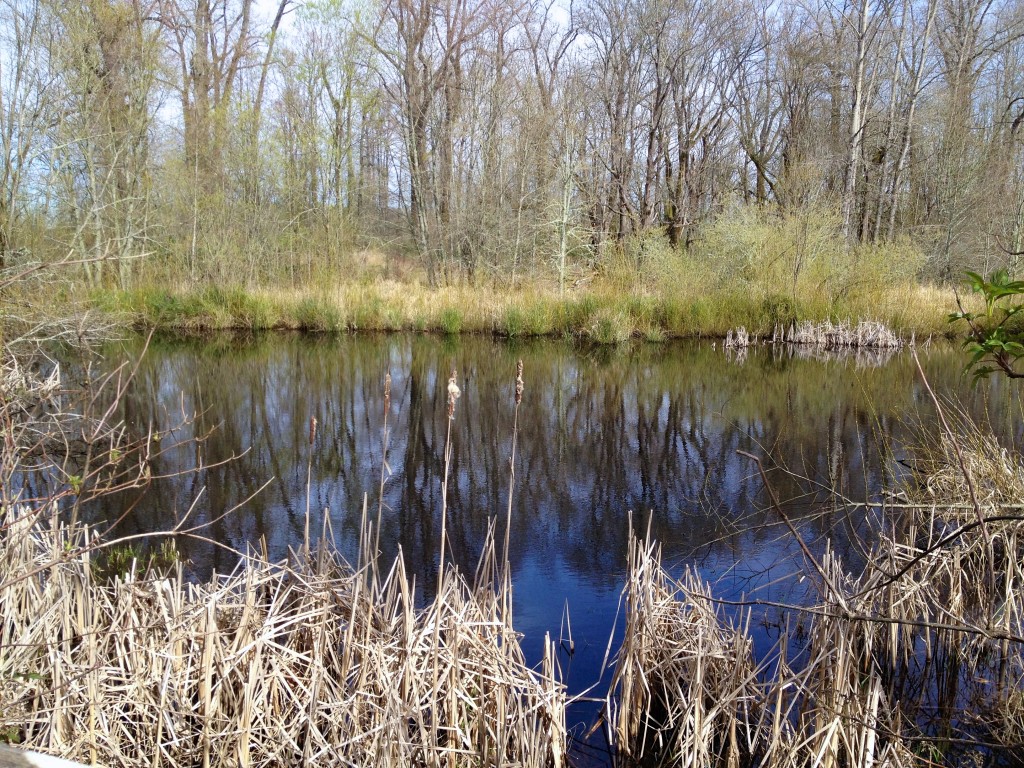
A perfect example of a riparian habitat: a highly diverse natural environment containing “elements of both aquatic and terrestrial ecosystems which mutually influence each other and occur as transitions between aquatic and upland habitats” (quote from the website of the Washington Department of Fish and Wildlife)
The estuary itself, at low tide, was a shelf of red mud, crisscrossed with the tracks of all sizes of seabirds.
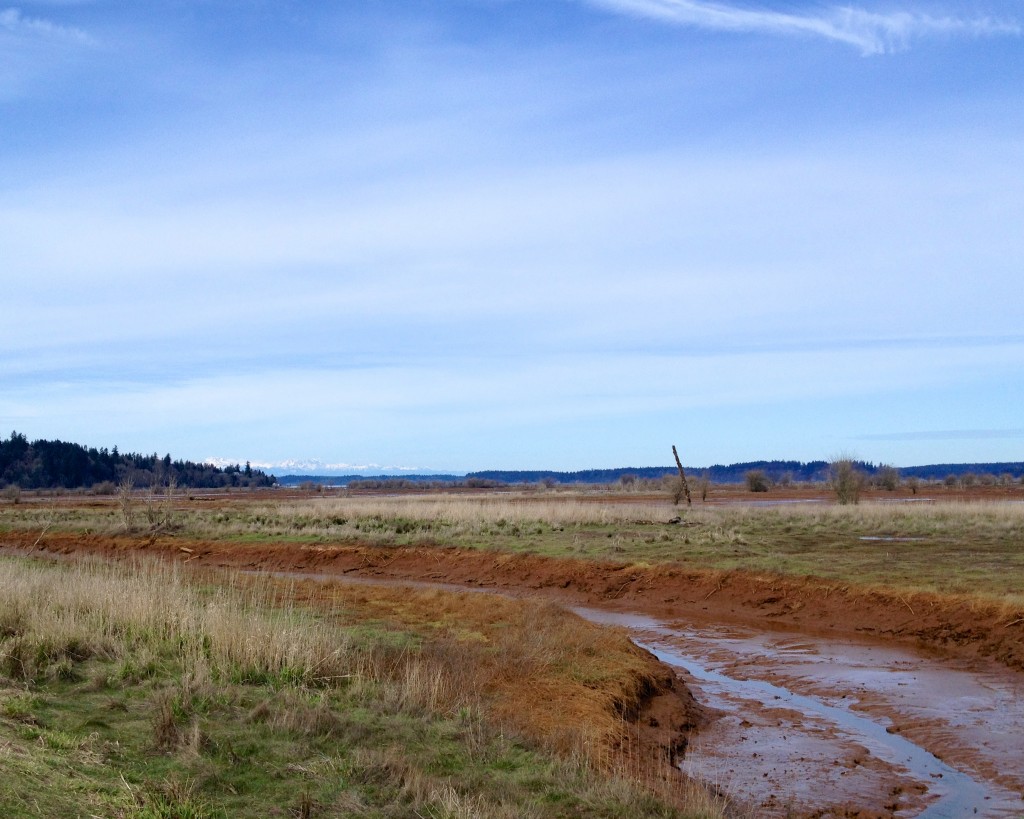
The salt marsh at low tide. Far in the distance (just left of center) are the Olympic Mountains. Since the dikes surrounding this part of the marsh were removed in 2009 to allow for a natural recovery of the estuary, the trees that had previously lived there are dying because of contact with the salt water. This in no way harms the flora and fauna that naturally occur on the estuary.
I will not replicate here there full, rich descriptions of the flora and fauna now thriving in this wonderful refuge, as these are presented on the Nisqually National Wildlife Refuge website.
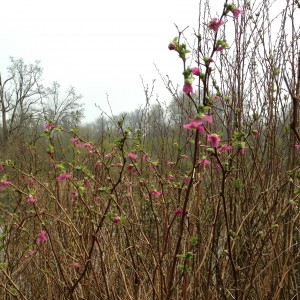
Salmonberries (Rubus spectabilis) in bloom – another quintessential early-flowering Pacific Northwest native plant
Seabirds, shorebirds, songbirds, raptors, mammals, amphibians, reptiles, fish, clams, worms … the list of animals alone is almost endless.
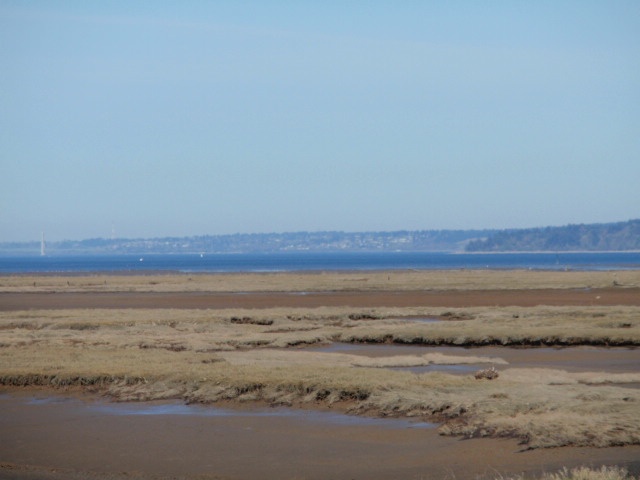
View from the observation platform at the very end of the boardwalk, looking out over the estuary toward the open water of Puget Sound
What caught my attention the first time I visited the refuge, however, was the overlap between the estuary restoration project intended to heal the environment by removing seven miles of dikes, and the healing that is also going on among the original inhabitants of this land in the aftermath of the 1854 Treaty of Medicine Creek.
First, some local history. As described in “Treaty Time at Nisqually”, a piece written for the Washington State Historical Society by Hope Cecelia Svinth Carpenter, a Nisqually tribal elder, historian, and author who became chief consultant on Indian history for the Society, Native people who lived in the Nisqually Delta region in the early part of the nineteenth century interacted initially with British fur traders, who were not interested in settling in the area. By the mid nineteenth century, however, that pattern changed, following the 1850 Donation Act passed by the United States
which stated that each white man could claim 320 acres which doubled if he were married. The United States claimed authority over the Indian people; to give the settlers title to their donation land claims, the process of extinguishing Indian ownership began.
The Treaty of Medicine Creek [She-nah-nam, later called McAllister Creek] was set up to remove Nisqually ownership of the land and clear the way for American settlement. What a shock it was for the Nisqually people. They learned of the disenfranchisement (when plans for it were already under way) as they were told to gather at the mouth of Medicine Creek….
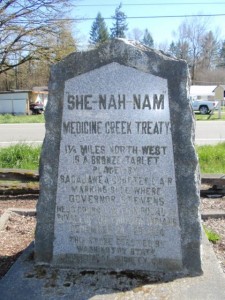
This treaty marker is not actually located at the place of the treaty-signing, but is in front of a gas station on the Nisqually reservation.
And from this point on, the story gets even sadder, and yet, there are elements of hope in it as well. One of the many educational signs placed on the boardwalk at the Nisqually National Wildlife Refuge shows an artist’s rendering of the treating-signing ceremony, accompanied by the following text:
The Medicine Creek Treaty
In the early 1850s, the Puget Sound country was filling with American settlers, drawn by the government’s promise of free land — land that still belonged to Indian tribes. In 1854, Territorial Governor Isaac Stevens embarked on a treaty-making mission to obtain these lands.
In December, over 600 members of the Nisqually, Puyallup, Squaxin, Steilacoom and other tribes met with Governor Stevens at their traditional meeting ground on McAllister Creek (then called She-nah-num or Medicine Creek). The treaty was signed under three Douglas fir trees on the southwest corner of what was later to become the Brown Farm. The last remaining tree from the grove toppled over in 2006 during a wind storm.
The Medicine Creek treaty, signed on December 26, 1854, gave 2.5 million acres of Indian lands to the U.S. government, except for three small parcels reserved for the tribes. But one of the Nisqually leaders, Leschi, realized that the treaty would be disastrous to his people and refused to sign.
Tensions mounted and war broke out in September, 1855. It ended ten months later, with the largest Nisqually village, Me-schal, destroyed and Leschi captured. But as a result of the war, Governor Stevens agreed to enlarge the Nisqually and Puyallup reservations. Leschi was hanged in 1858 for allegedly killing a soldier. In 2004, the Washington State Supreme Court exonerated Leschi and today, he continues to be a hero to his people. In 2011, the longest tidal slough in the newly restored estuary was officially named Leschi Slough in honor of this Nisqually leader. The treaty reserved for the Tribes the right to fish in their “usual and accustomed places,” including off the reservation. Today, over 150 years later, the Nisqually people still exercise their treaty rights.
Clearly, despite the attempts of the new sign on the recently erected boardwalk to brush over the most painful parts of the story and emphasize instead Leschi’s perspicacious heroism as well as the continuing, present-day vitality of the Nisqually tribe, what was involved here in the mid nineteenth century was racist trickery if not treachery. Governor Stevens had ordered the treaty to be translated into Chinook jargon, a very simple patois or trading pidgin developed during the fur trade era, even though Frank Shaw, an older white trader who often served as an interpreter, could have translated the document into the Salish language the Indians spoke. The land ceded to the U.S. government was considerable: 2.5 million acres of the Indians’ homelands, reaching from the salt marsh estuary on Puget Sound, through prairie lands, all the way back to the source of the Nisqually River 78 miles away on Mt. Rainier. And the governor was not unaware of the moral force of the leader Leschi, who, recognizing the impending disaster represented by the treaty, had refused to sign it. Hence the story gets even more dark.
Three accounts — the first, a brief newspaper article from 1998, the second, an online article from the Summer, 2006 issue of Justice Denied magazine, and finally, a full-length book published in 2011 – shed further light on this complex tale.
In the first case, Seattle Times columnist Erik Lacitis wrote a column (“The Medicine Creek Treaty of 1854 Set the Stage for Future Generations”) providing some background for an extraordinary museum exhibit that would be coming to the Puget Sound area in November of that year (1998): the actual parchment document, the Medicine Creek Treaty itself, was to be flown from the National Archives in Washington, D.C., in its own commercial plane seat, and would be watched over by a 24-hour guard while on display for two weeks at the Washington State History Museum in Tacoma. Although Lacitis does not explicitly explain the reason for the guard, the document is obviously something that still has immense power to stir up intense emotions. Commenting on the “signatures” of the sixty-two Native leaders who purportedly signed the treaty, Lacitis makes the following observations:
It is the page with the X’s that stops those looking at this document. The 62 Indians could not read or speak English. There were no negotiations about the wording. It wasn’t even translated directly into the Salish language, which Shaw and other whites could speak….
You read the X’s, and you see the one attributed to “Lesh-high,” with an “L.S.” after it, for “legal seal.” Later, the Indians would say that Leschi refused to sign and tore up the document naming him a chief. Relegated to reserves in what then were considered the worst lands, it was inevitable that the Indians would go to war, just as it was inevitable that they’d lose. After the year-long war, Stevens made it his mission to hang Leschi, who had become a lightening rod for white fear. He succeeded.
How this happened, that is, how (and why) Territorial Governor Isaac Stevens “succeeded” in having Leschi hanged, and how and why, over one hundred and forty years later, the Washington State Supreme Court exonerated the Indian leader, is told in the other two accounts.
The story is a long, complicated and sad one, involving the shooting and subsequent death of a white man during a firefight between territorial militia and members of the Nisqually tribe. Leschi was blamed for the death, ordered arrested, put on trial (ending in a hung jury), retried, this time convicted of murder, sentenced to death, and ultimately hanged in 1858.
His exoneration is described by Hans Sherrer in his 2006 article “Chief Leschi Exonerated of Murder – 146 Years After His Execution” in Justice Denied magazine:
The trial was arranged to be held on December 10, 2004, in a make-shift courtroom seating about 200 people in the basement of the Washington State Historical Society in Tacoma. Seven judges were selected to sit in judgment of the case – six state judges, including Chief Justice [Gerry] Alexander, and a judge representing the Nisqually Tribe…. A team of lawyers, led by John Ladenburg, represented Leschi in absentia…. Ladenburg closed by telling the judges, “We cannot bring Leschi back to life, and we cannot restore Leschi to his land. We can, we must, restore his good name…. The only fair and just result for a historical court is to correct the historical record of our state and declare Leschi exonerated.
Even more background for understanding the various strands of the Medicine Creek Treaty story is provided in the full-length book by Pulitzer Prize-winning author Robert Kluger: The Bitter Waters of Medicine Creek: A Tragic Clash between White and Native America (2011) – a work which meticulously focuses on the “tragic clash” between two very different orientations toward the land : that of the whites, who prioritize profiting from and controlling nature, and that of the region’s indigenous inhabitants, who put more emphasis on living in harmony with nature. As Kluger points out in his Preface,
The Bitter Waters of Medicine Creek does not attempt an encyclopedic survey of the interaction between the red and white races on these shores, so calamitous to the former, so ignoble of the latter. It is meant to be not a compendium but an illustration. In focusing on the experience of a single small tribe, the book aspires to make a monumental tragedy more accessible and comprehensible; the smaller the scale, the keener our perception may become of an unfolding human drama.
And yet the experience of this “single small tribe”, the Nisqually, is not simply “a monumental tragedy” that took place a century or more ago. Even though the effects of the Medicine Creek Treaty were indeed calamitous, ironically, in view of Governor Steven’s original intent, they also provided an opening for redress if not healing. As Erik Lacitis pointed out in his 1998 column about the treaty exhibit,
The Medicine Creek Treaty set the tone for a dozen more treaties negotiated by Stevens, in which tribes gave up rights to over 200,000 square miles. However, there was one article in this first treaty that set it apart….
“The rights of taking fish, at all usual and accustomed grounds and stations, is further secured to said Indians….”
These last nineteen words were originally put in the treaty by Territorial governor Stevens as a shrewd way of insuring that the Indians, living on cramped reservations that no longer bordered salt- and fresh-water shorelines, would not have to be fed by the U. S. government, but rather, could leave their otherwise hemmed-in lands to continue to fish and harvest shellfish in their traditional ways (as well as continue to provide food for white settlers). These words took on high-voltage meaning during the 1960s and 1970s when the “fishing wars” (at times deliberately carried out in camera-accessible public places such as near the state capitol and interstate highway in Olympia) were filmed by news crews and shown regularly on the evening TV news. What these film clips showed was Indians, defiantly fishing or getting ready to fish in their “usual and accustomed grounds and stations”, being pulled out of their boats, sometimes clubbed and tear-gassed, and then hand-cuffed, arrested and stuffed in police vehicles by state game wardens and police for violating then-current state fishing regulations.
In the following fifteen-minute video, Nisqually leader Billy Frank (born in 1931, chairman of the Northwest Indian Fisheries Commission since 1981), summarizes what led up to these powerfully affecting demonstrations (which brought support in the form of the physical presence, at some of these deliberately staged “fish-ins”, of such well-known [in the 1970s] public figures as Marlon Brando, Buffy Saint Marie, and Dick Gregory).
Ultimately, these years of protests, judiciously planned and organized by such Native leaders as Frank, Robert Satiacum (Puyallup) and Hank Adams (Assiniboine and Sioux) ended with a historic ruling, given on February 12, 1974, by Federal Judge George Boldt. “The Boldt Decision” as it came to be called (explained in more detail by Robert O. Marritz in a March 10, 2009 HistoryLink.org essay on Billy Frank) reaffirmed the rights of Washington’s “treaty Indians” to fish in their “usual and accustomed grounds and stations”. Furthermore, it tried to forestall the outbreak of further contention between Native fisherfolk and commercial and sport fishing groups by stipulating a very significant interpretation of the phrase “in common” in the following clause in the treaty – “The right of taking fish at usual and accustomed grounds and stations is further secured to said Indians in common with all citizens of the territory”. Judge Boldt’s decision meant that treaty Indians were entitled to one-half of the harvestable salmon and steelhead of each year’s fish harvest. Not surprisingly, this interpretation enraged most non-Indian fishers, who engaged in their own counter-demonstrations, often hanging Boldt in effigy.
So how does this backlash against Indian fishing rights lead, or even relate to, the theme of healing that I initially set out to write about?
It doesn’t yet. In fact, to heal, it is often necessary to scrape out the pus and the toxins first. It would be prematurely naive to exult over the spectacular sight of the new boardwalk built over the breached dikes and the slowly returning natural estuary at the Nisqually Delta without at the same time acknowledging all the problems that still bedevil the environment, both human as well as natural. Salmon runs are indeed still precipitously low – a fact emphasized in a recent (January 5, 2013) Seattle Times article (“Tribes: Hard-Won Fishing Rights Here Worthless without Fish“) that quotes Billy Frank’s sad observation about this year’s run of chum salmon being so poor that the tribe had to shut the season down earlier than ever before. Even more sobering are the more than one hundred fifty reader Comments following the story, many expressing all-too predictable sentiments of “blame-the-greedy/lazy gill-netting Indian for that”.
Furthermore, a wider perspective such as that taken by anthropologist and lifelong professional fisherman Peter Knudson identifies even more complex problems still to be addressed. In his article he wrote in 1987 for the issue of the anthropological journal Cultural Survival dedicated to the theme of indigenous Fishing Communities, “The Unintended Consequences of the Boldt Decision“, Knudson points out how the decision
appears to be encouraging the creation of a wealthy class of offshore, capital-intensive, treaty-tribe fishermen who are intercepting much of the resource before it reaches the traditional estuary and river fisheries of the tribes. In essence, the results of the federal intervention have accelerated the transformation of traditional tribal fisheries. In contrast to the competitive entrepreneurship associated with the common-property [i.e. non-native] salmon fisheries, traditional tribal fishing has been characterized by strong collective, redistributive and ecological commitments. However, as treaty members adopt privately owned, capital-intensive fishing technologies such as purse-seining and marine gillnetting, new commitments are made that do not necessarily harmonize with traditional values.
Knudson is not without hope for the evolution of what he calls “a new fisheries paradigm” that would have “popular legitimacy” and which could also “address the cultural needs of both treaty Indians and nontreaty fishermen”. And perhaps this hope is just what we need to allow our conversation about a river, an estuary, a tribe, and a treaty to return to the overall theme I wanted to address so simply at the beginning of my exploration of the Nisqually: evidence of healing.
But first, one more meandering stream that likewise feeds into this discussion also needs to be acknowledged: the impact of casinos and other such new forms of tribal revenue production. In what ways does the Native American gaming industry improve the chances that the Nisqually and other Native people, particularly the young generation, will be better able to be effective twenty-first century stewards of the land?
If this piece of writing were an academic article intended for an audience of fellow academics, this would be the place for me to cite the numerous, carefully designed studies I would have consulted on this topic. Wanting instead to return to a more personal, less academic sharing of my thoughts and reflections, I will simply make reference here to one such study, published in the Summer, 2010 issue of American Indian Quarterly and repeatedly cited in multiple publications across multiple academic fields: James I. Schaap’s “The Growth of the Native American Gaming Industry: What Has the Past Provided, and What Does the Future Hold?”
Schaap acknowledges that some public backlash has indeed followed the growth of Indian gaming operations throughout the country, even though, as he also points out, “poverty in Native American country is an everyday reality that pervades every aspect of Native American life” (2010: 373). His entire article, based strictly on published data from governmental agencies and a non-profit agency rather than data he collected personally, is cautiously optimistic about the socioeconomic impacts of Indian gaming. At the same time, he points out how complex are the entanglements here, involving “sovereignty, constitutional law, shifting courts, state domination, historical locations, compact processes, modernity, economic development, politics, and so on” (2010: 381).
While my own ability to add any insight to this discussion is limited to my experience as a professor at a private liberal arts university, where relatively few Native students have, up to now, pursued their undergraduate degrees, I can still corroborate the importance of one of Schaap’s findings. Tribal gaming activities allocate a hefty chunk of their profits to education, making higher studies possible to young people who, a generation ago, would have had no hope or chance of attending college. Beyond this, casinos contribute to other tremendously important programs targeting the welfare of elders, continued cultural development for all ages of tribal members, housing, health care, infrastructure, charity, and of course, economic development. But it is the grants and scholarships for deserving young people that is most centrally related to the concerns of this essay. Now, with the significantly increased possibility of Native students studying at high quality post-secondary institutions, the “new fisheries paradigms” Knudson hoped for would seem to have a much better chance of becoming a reality.
And what might these new paradigms look like? Marine biologist, author, and filmmaker Carl Safina of the Blue Ocean Institute, as host of the PBS series Saving the Ocean: Stories of Hope and Innovation, gives viewers a spectacularly good look at reasons for hope for the future of the Nisqually River in the two-part documentary Bringing Salmon Back. (The two embedded portions of the program below – two 20-minute segments each – leave out clips of the “fishing wars”, the dike removal work that began the Nisqually estuary restoration project, and the fish weir now being used to separate returning hatchery fish from the “new-wild” chinook. Use these two [non-embeddable] links instead to see the complete 52 minute program: River of Kings, Part 1 and River of Kings, Part 2.)
Watch River of Kings, Part 1 on PBS. See more from Saving the Ocean.
Watch River of Kings, Part 2 on PBS. See more from Saving the Ocean.
Even the abbreviated clips from the PBS website make clear how much the health and healing of the Nisqually benefits from blending ancient tribal wisdom with modern biological and engineering expertise. Moreover, the final portion of the full-length movie, featuring the commentary by David Troutt, Director of Natural Resources for the Nisqually tribe, illustrates this kind of hybridization even more pointedly.
On the one hand, “pure” wild chinook salmon are extinct in the Nisqually River. On the other hand, due to both luck (the Nisqually was never terribly polluted nor completely ruined for salmon by dams), and careful stewardship and management by traditional tribal leaders protecting treaty rights as well as modern tribal fisheries experts and other environmental scientists, “new wild” chinook are slowly coming back.
What has been happening is this: most of the salmon returning from the ocean to spawn in the waters of their hatching site return, of course, to “their” Clear Creek Hatchery, where they are welcomed as a source of food and income for the Nisqually people as well as other local populations. But every year a few hatchery fish “stray”, and some of these strays have been managing to spawn naturally in upstream tributaries of the Nisqually river (below the two dams). The sixth-generation descendants of these fish (which typically spend three or four years in the ocean before returning to fresh water) are thus becoming the relatively recent ancestors of “newly wild” chinook.
But if this is a source of joy and hope to those who want to see the restoration of wild chinook (even if not “purely” wild), there is also a problem. As the River of Kings film makes clear, newly escaped hatchery fish (which are easily identified by their clipped-off adipose fin, which would have been removed from the smolts, or baby salmon, before they were released from the hatchery) are far more numerous than the fish that never saw a hatchery. How to separate the more-nearly wild salmon from the “recent escapees” so that the natural spawning grounds are not too crowded for the wild fish to reproduce successfully?
Using temporary fish weirs! That ancient technique used by indigenous fisherfolk around the world has been updated and adjusted to allow for the separation of hatchery-spawned and raised (adipose fin-clipped) salmon from those whose parents spawned naturally in the two upstream tributaries of the Nisqually River (see the news story in The Olympian published September 22, 2012: “Nisqually Tribe Has New Tool for Separating Wild, Raised Salmon“, and watch the end of the full-length film [River of Kings, Part 2] to see how this is happening).
To be sure, the story in the newspaper is not a completely happy one. Runs of returning salmon in the 2012 fall season were lower than forecast, and the Comment section following the story is unfortunately replete with ignorant and even hateful opinions about Indians, treaties, the Boldt decision, reverse racism, and “special rights”.
But maybe this pattern too – hope mingled with ugliness – is part of the complex mosaic that characterizes healing, which, after all, implies injury and pain as well as recovery. People whose lives are touched by the Nisqually River and its delta are cooperating, while still sometimes disagreeing, about the way life is coming back there. Removing the dikes in 2009 required the use of sometimes loud and sanctuary-disturbing heavy equipment as well as modern biological and engineering knowledge and technical skill. Preserving the Nisqually delta as a wildlife refuge in the 1970s, when powerful people wanted to dredge it and make it a deepwater port, required the united agency and action of many different constituencies of people from many different backgrounds. The healing process is by no means finished. To fight the deleterious effects of past wrongs done to the land, the waters, to groups of people as well as to individuals like Chief Leschi, to undo the harm done by unfair treaties, still requires courage and vision.
Should we cheer the new-wild chinook that are slowly returning? I think so. “Pure wild”, like “pure native”, is an abstraction, a reified category label. If nature is our model here, look around at the surprising interconnections therein. Birds have built their nest in a salmonberry thicket growing right next to the Visitor Center at the refuge. Who knows if or how that surprisingly heartwarming sight might have already inspired some visiting child – or nature photographer – to see things (their own life? our society and its problems? painful events or relationships?) in a different, potentially “pain healing” way?
Eighty miles away from the mouth of this delta, the 500-feet thick Nisqually Glacier keeps on slowly dripping its icy meltwater into what becomes the headwaters of the Nisqually River. What we call “Mount Rainier”, the source of that river, which the original residents of this part of the land have called Tahoma or Tacobet – is almost magically visible, on clear days, from the observation platform at the end of the boardwalk. Almost one hundred sixty years after the signing of the Treaty of Medicine Creek, that unspoiled sightline can be seen either as a sobering reminder of what we all almost lost, or as a promise that, if we continue to work together, the healing can likewise continue.

